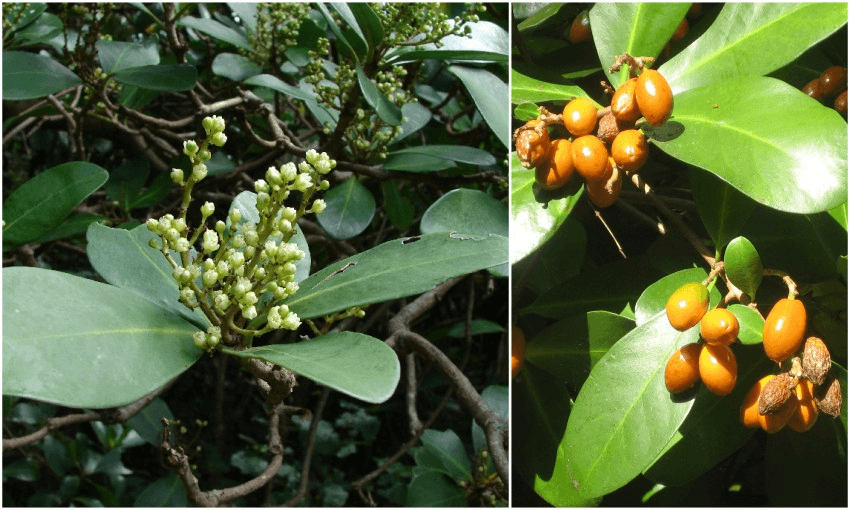Karaka berries are a good source of protein and carbohydrates but can be toxic if not prepared properly. Rongoā and traditional healing practices tutor Donna Kerridge shares the many excellent attributes of this beautiful berry.
The flowers of the karaka (Corynocarpus laevigatus) herald the appearance of the stars Kopu and Tautoru in July. As the karaka berries start to ripen they signal the rise of Rehua (Antaries) in December. Fruiting karaka is a sign that kereru and kiore will soon be at their best for harvesting, having fattened themselves up on karaka berries. Karaka whati (the broken karaka leaf) is an ancient ritual performed over warriors using a branch from the karaka tree before they went off to war. The karaka berry imprints on Auckland’s spaghetti junction motorway barriers mark the site of an important karaka grove that once existed in that area.
Not only is the karaka tree grand in appearance among the treasures of Tane but it has many uses. Sturdy, sacred and healing the karaka tree produces large orange, sweetly aromatic, oval berries that were a good source of carbohydrates (60%) and protein (10%) for Māori in the lean winter months. Berries are produced in great abundance by the female trees and to a lesser extent by mixed male/female trees. The karaka tree is highly prized by Moriori and Māori alike and if your hapū had its own pā karaka it was considered a symbol of status.
These trees were meticulously cared for and moss was regularly cleaned off them to ensure a good fruiting season. Karaka trees in many of these sites appear to have been planted and especially selected to bear larger fruits than those found elsewhere. These groves were also useful navigational markers as their large glossy leaves stand out from other vegetation when viewing them from a distance. For Moriori not only are the berries prized but also the wood, which is used to smoke and preserve foods in much the same way Mānuka is used by Māori today.
Possums and kererū are also known to eat the ripe flesh of the karaka berries, although these same berries are known to be toxic to other animals including dogs, pigs and cattle. The nectar of the karaka flowers is also reported to be toxic to bee colonies.
Now is the time for gathering your karaka berries (February- April) for processing and storing for later use. Dried karaka berry kernels were an important kai for Māori and helped sustain communities over winter when carbohydrates were scarce. Despite containing a highly poisonous alkaloid, Māori learned to process karaka kernels so that they are safe to eat – practice that continues to this day in and around Kawhia, East Cape, the Chatham Islands and other coastal areas of New Zealand.
The following is a recipe for the safe preparation of kopi (karaka) berries. It is shared here with the kind permission of my dear friend Matua George Day from Rekohu, Chatham Islands:
“Pick your kopi berries off the ground when they are ripe and have that strong kopi smell about them, for us on Rekohu, this is usually around February/March. Cover your berries in water, any that float have no kernel so discard them.
“On a gas ring, put the rest of the berries in a pot and just cover with water. Then put a good layer of Kawakawa (Macropiper excelsum) and Poroporo (Solanum lanciniatum/alvicurae) leaves on the top, about 50/50, virtually just steaming the leaves to draw out the poison from the berries. Bring to the boil and simmer for about 6 – 8hrs with the lid on. You may have to keep topping the water up or add more leaves on top if they boil down. Leave the berries in the water to cool overnight.
“In the morning tip the berries into another container and take them down to the creek to rub all the skin and flesh off the berries. Use a slatted bin, a plastic fruit bin is ideal, to rub the berries against and let the stream water carry away the flesh and skin. When this is done put them in a muslin cloth, old onion sack or a flax kete and put them to soak for five days in a running creek. Alternatively, you can put them in a bucket or a large pot at home for five days, but you must change the water every day.
“Then they are ready to eat. Just bite them or cut them in half to squeeze the inside flesh out. They taste like the smell of ripe Kopi berries and are delicious to eat.
“Anei ngā mea i whakataukitia ai e ngā tūpuna, ko te kaha, ko te uaua, ko te pakari, ko te kaha i te toki, ko te uaua i te pakake, ko te pakari i te karaka
“Here are the things valued by the ancestors, it is the strength, the vigour, the sturdiness, it is the strength of the adze, the vigour of the whale and the sturdiness of the karaka tree.”
